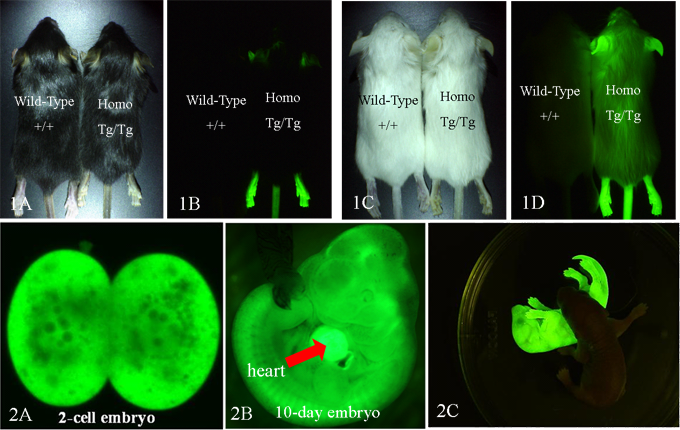Green congenic mouse strainsC57BL/6-Tg(CAG-EGFP)C14-Y01-FM131Osb RBRC00267C.B6-Tg(CAG-EGFP)C14-Y01-FM131Osb/Rbrc RBRC01624C3.B6-Tg(CAG-EGFP)C14-Y01-FM131Osb/Rbrc RBRC01625MSM.B6-Tg(CAG-EGFP)C14-Y01-FM131Osb/Rbrc RBRC01626D2.B6-Tg(CAG-EGFP)C14-Y01-FM131Osb/NyRbrc RBRC02889
Dorsal view of green C57BL/6 mice at 17 days old under (1A) white illumination and (1B) epi-fluorescence illumination. Green BALB/c mice at 17 days old under (1C) white illumination and (1D) epi-fluorescence illumination. Fluorescence in the skin is less visible in Black mice than in albino mice. Green fluorescence can be detected during different developmental stages, such as (2A) a 2-cell stage embryo, (2B) a 10-day embryo, and (2C) a newborn pup. |
The green mouse strain was originally generated using the C57BL/6 background and expresses enhanced green fluorescent protein (EGFP) under the control of a chicken beta-actin promoter and cytomegalovirus enhancer (CAG promoter) [1]. The green mouse has been widely used in various developmental studies to visualize cell fate in vivo [1-3]. Recently, there has been an increasing demand from researchers for this in vivo fluorescent marker system to be extended to other useful inbred strains. To meet these requests, original C57BL/6-Tg(CAG-EGFP) mice were backcrossed with BALB/cAn, C3H/HeN, DBA/2Cr, and MSM/MsRbrc inbred strains to establish green mice in five different inbred strains. The genetic background of each strain was then examined using simple sequence length polymorphic markers to assess congenic status. A genotyping protocol was also established to distinguish homozygous and hemizygous transgenic mice. These green congenic mice will be useful for various cell transplantation studies to monitor the fate of donor cells in different genetic backgrounds.
Depositors:
Dr. Masaru Okabe, Osaka University
C57BL/6-Tg(CAG-EGFP)C14-Y01-FM131Osb RBRC00267
Dr. Masaru Okabe and RIKEN BioResource Center
C.B6-Tg(CAG-EGFP)C14-Y01-FM131Osb/Rbrc RBRC01624
C3.B6-Tg(CAG-EGFP)C14-Y01-FM131Osb/Rbrc RBRC01625
MSM.B6-Tg(CAG-EGFP)C14-Y01-FM131Osb/Rbrc RBRC01626
Dr. Naoki Yamamoto, Fujita Health University
D2.B6-Tg(CAG-EGFP)C14-Y01-FM131Osb/NyRbrc RBRC02889
References:
- Ikawa, M., Yamada, S., Nakanishi, T., and Okabe, M. 1999. Green fluorescent protein (GFP) as a vital marker in mammals. Curr Top Dev Biol 44: 1-20.
- Kato, M., Yamanouchi, K., Ikawa, M., Okabe, M., Naito, K., and Tojo, H. 1999. Efficient selection of transgenic mouse embryos using EGFP as a marker gene. Mol Reprod Dev54: 43-48.
- Okabe, M., Ikawa, M., Kominami, K., Nakanishi, T., and Nishimune, Y. 1997. ‘Green mice’ as a source of ubiquitous green cells. FEBS Lett 407: 313-319.






